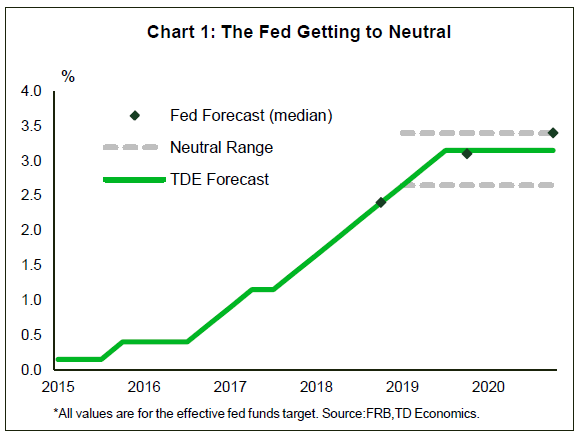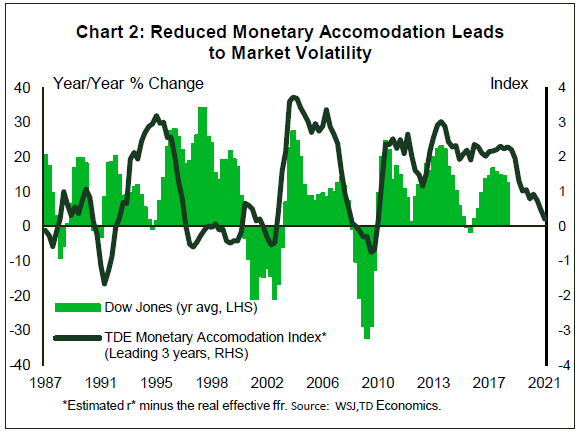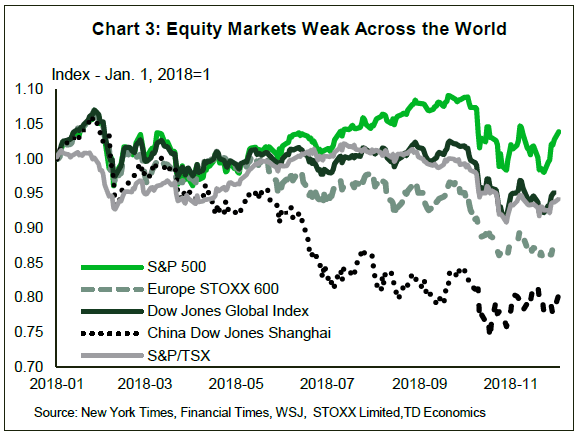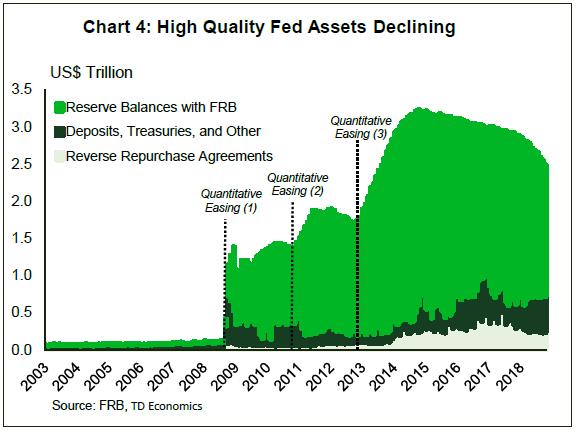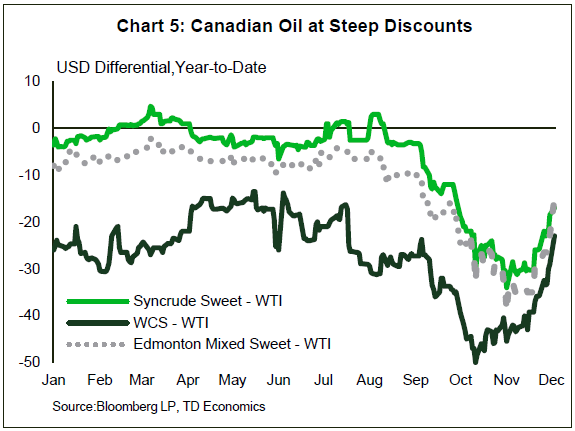Highlights
- 2019 is likely to represent the peak level of interest rates for the U.S. and Canada. The debate among market participants will continue to heat up on whether central banks will succeed in finding the sweet spot in the neutral rate.
- Policymakers will have to double-down on efforts to monitor incoming economic and financial data during this last phase of the rate-hike cycle. High on the watch list will be any sharp deterioration in consumer/business confidence within a slowing global economy.
- There has been some market concern related to a potential stress on commercial banks from the continued draining in excess reserves. Though we believe this is much ado about nothing, the Fed will have to provide clarity on its intention of excess liquidity within the banking system.
- The Bank of Canada has only one policy lever to focus on, the overnight rate. However, the balance of risks for Canada is more to the downside than its U.S. counterpart, given overstretched households and the recent negative shock to local energy markets.
Three years ago, the Federal Reserve raised its policy rate for the first time since the global financial crisis. While it wasn’t the first central bank to hike, previous attempts by others proved premature. For example, the Bank of Canada was one of the first out of the gate, but had to reverse course as weak oil and broader commodity prices dragged down economic growth prospects in 2015.
The Federal Reserve’s cautiousness didn’t go away once they began hiking rates. After a single rate hike, a full year elapsed before another followed, while it assessed the global economic stress stemming from China. Once that risk proved benign, the FOMC re-started the pace of interest rate hikes. Now, with 200 bps under its belt and another 25 bps coming in December, the Fed’s target rate will have entered the bottom end of estimates for the neutral rate (Chart 1). This leaves them facing three important questions in 2019. Will the Fed find the sweet spot within the neutral range, cited as 2.50-3.50%? What will be the interplay of global and financial market movements? And, how will balance sheet runoff be evaluated alongside both of these backdrops? With the exception of the balance sheet question, the Bank of Canada will be facing a similar decision set.
How high will rates go?
The policy decisions of the Fed are directly based on the dual mandate of full employment and stable prices. On the former, the mandate has been filled in a broad sense. There’s no light that suddenly goes off to tell us this, but there are a number of labor market indicators that offer confidence. For instance, the unemployment rate sits at 3.7%, well below the Fed’s 4.5% assumption for the natural rate. Furthermore, the amount of people feeling confident enough to leave current jobs is at a record high, and businesses are consistently reporting increased difficulty in filling positions. Supporting this notion, aggregate wages breached 3% for the first time since the recession. Is there room to draw more workers into the labor force? We suspect the answer is yes. Participation rates of 25-54 year olds are at a cyclical (but not historical) high, and there are about 4.6 million people still working part time for economic reasons. Even so, none of this overcomes from the reality that marginal increases in labor are getting tougher to come by and the data convey a tight labor market.
As wage and other input prices place pressure on the operating costs of businesses, this is eventually passed through to consumer prices. After years of disinflationary pressures, the Fed’s preferred metric of core PCE has largely stabilized around the 2% target rate. There are no alarm bells going off on this front, and recently the trend has even ebbed. But, the balance of risks is tilted to the upside so long as labor markets remain tight and the overall U.S. economy runs at an above trend pace.
Putting all of this into a monetary policy rule tells us that the Fed should raise rates closer to the mid-point of the neutral range, rather than keeping rates at the bottom end. However, this is now the “fine tuning” stage of the policy rate cycle. There is broad agreement that the Fed is within the scope of the neutral level, yet there isn’t agreement on its precise level. That means we will likely see greater diverging views among Fed members (within speeches and voting dissents) relative to the past year, when voices were largely in unison about the direction and pace of rate hikes. Likewise, financial markets will remain sensitive to gyrations in the data and be more “opinionated” on the Federal Reserve’s judgement as peak interest rates come into sight. This is the stage in the interest rate cycle where volatility in equity market movements can become more exaggerated (Chart 2), however this does not necessarily correlate to a downturn in the economic cycle. It’s merely warning shots being fired by investors, as recalibration occurs on expectations for corporate earnings and business cycle risks.
How much do global and financial market risks matter?
With clear evidence that economic momentum has already downshifted in the second half of 2018, the New Year will usher in ongoing questions regarding the stability of the global economy. Ever since the U.S. Administration’s steel and aluminum tariffs, both consumer and business confidence (outside of the U.S.) have eased from elevated levels. More recently, there’s even evidence that U.S. order books are wavering, particularly business sentiment indicators on export orders. Equity and currency markets have indicated their angst (Chart 3), with global markets negative on the year. At this point, 2018 marks the worst year for global equity returns since 2015. The S&P 500 has fared better, holding onto a roughly 4.5% year-to-date return. In turn, safe-haven flows have pushed up the greenback by 8% against its broad trading partners over the year. This narrative is drawing a lot more investor concern and you better bet the Fed is closely watching these developments.
There’s no question that global growth hit the high water mark in the first half of 2018, but this is not a surprise. We had forecasted slower growth, consistent with the fact that momentum was too high relative to its sustainable running speed. However, the knock-on impacts of trade tensions has certainly rung some alarm bells that global growth might now overshoot to the downside, rather than stabilize as we hope. The source of deceleration is largely stemming from emerging market economies. Growth is slowing from Latin America to East Asia. Ground zero appears to be in South East Asia, specifically China, India, and the ASEAN economies, influencing global trade, the commodity channel, and corporate profits. The recent developments from the G20 summit, where an escalation of U.S.-China trade tariffs will be delayed for 90 days is certainly favorable. But, the lack of specifics from both countries and a defined resolution means that the risk-environment remains high.
By the same token, U.S. growth hit a high water mark about three months ago. Although this was a bit later than the global economy due to the fiscal stimulus impulse, momentum is ultimately constrained by the economic fundamentals. GDP growth for the fourth quarter is tracking about 2.5%, down from close to 4% annualized during the previous two quarters. The step-down in global and U.S. growth prospects will leave financial markets more sensitive to gyrations in the data.
It is important to confirm that even though investor confidence is coming down from a cyclical high, we have not yet seen a confidence shock. Advanced economy stock markets typically experience peak-to-trough sell-offs of 15% in any given year. Recent movements are still within the realm of normal, and the VIX is sitting at its historical average. However, if there’s a significant and sustained deterioration in equity prices (20% or more) alongside measures of business and consumer confidence, the Fed will hit the pause button on rate hikes.
Does size matter on the Fed’s balance sheet?
Part of the Fed’s communication in 2019 will also need to address investor questions on the next stage of its balance sheet. In June 2017, the Addendum to the Policy Normalization Principles and Plans was published – outlining the runoff schedule for the Fed’s balance sheet. Following years of asset accumulation through its quantitative easing (QE) program, reserves above what is required amounts to $2.4tn, down from $3.2tn in late 2014 (Chart 4). The run-off of the balance sheet was initiated in October 2017 to little market reaction and has neither impacted market stability, nor pushed Treasury yields significantly higher. However, some commentators are now quibbling about the potential for market stress to materialize if the total amount of excess liquidity in the system is drained too much. The question being asked is whether the Fed will strike the right balance between the needs of financial institutions and that of monetary policy?
There are several components to this question. The first rests in the mechanics of setting the target policy rate. The existence of a balance sheet in excess of what is required by the economy means that the Federal Reserve must use a “floor system” for setting rates instead of the channel system (open market operations) it used prior to QE. This requires an upper limit that is held in place by incentivizing financial institutions to leave their funds at the central bank in exchange for receiving interest on excess reserves (IOER). The lower limit is set via overnight reverse repurchase agreements (ON-RRPs) in order to make sure that rates don’t go below a predetermined floor. In combination, these allow the Federal Reserve to maintain an incentive system that keeps the effective fed funds rate within the target range. This system is working quite well and based on past Fed communication, we expect it is here to stay.
Keeping the floor system requires that excess liquidity remain in the system and that banks continue to hold these reserves on their balance sheets. This is important as commercial banks have been using reserves with the Fed to meet their regulatory requirements to hold specific amounts of high quality liquid assets (HQLA). In this way, the amount of excess reserves the Fed decides to leave in the banking system will directly impact banks (who are also collecting interest on these assets).
We see the Fed continuing to normalize until reserves above currency reaches a level around $500bn to $1tn. As the Fed drains reserves as part of their balance sheet normalization process, banks will need to find substitutes for HQLA. Some believe this opens the door to a policy error, with the Fed inadvertently creating strain on commercial banks, which will have to sell other risky assets to purchase HQLA to maintain regulatory ratios. We’re doubtful that this will cause any significant stress on financial institutions. Banks know the run-off schedule of the Fed in advance and the slow moving process will enable banks to gradually adjust the composition of their balance sheets in an orderly fashion. Furthermore, the bulk of excess reserves are held on the balance sheets of the largest U.S. banks. These holdings are well in excess of what regulations require. Therefore, the elimination of excess reserves is not likely to force large asset sales as some fear and the required transaction of substituting HQLA away from excess reserves will not cause systemic stress. Still, some investors may take an “I’ll believe it when I see it” attitude.
What to expect from the Bank of Canada?
Like the U.S. economy, the Canadian economy is demonstrating stable prices with several core measures of inflation all around 2%. The Bank of Canada is also in a position of normalizing interest rates back to neutral levels (which we think is around 2.25% to 2.50%). We believe the Bank will get to a neutral stance in 2019, but how it gets there is of great debate amongst economists.
Even with the Bank of Canada’s inflation mandate essentially filled, there are risks to the outlook that are unique to Canada and may slow the timing of rate hikes. The most familiar of these is the long standing risk related to over-leveraged households that may belt tighten more than expected. Already the consumer spending profile for the third quarter was less than impressive with a below-trend pace of 1.2%. More recently, a new kid on the block has shown up as a primary risk to the outlook – weak Canadian energy prices and the knock-on impact to economic momentum from production and employment cuts. An intensification of shipping constraints have caused Canadian oil prices to be heavily discounted (Chart 5), forcing the Alberta government to cut production. Even with refineries ramping-up production and more rail capacity becoming available, it will take time to reduce high inventories. The discount on Canadian energy is likely to hold at above-average levels relative to history. More importantly for Bank of Canada consideration, recent developments will markdown economic momentum, with particular negative impacts to income and Canada’s terms of trade. Although this may prove to be only a temporary influence in the data, their risk-management framework argues to monitor developments and ensure the forecast remains on track before moving forward with further rate hikes. At the time of writing, our tracking for real GDP in the fourth quarter of 2018 is below the Bank of Canada’s 2.4% forecast by roughly a full percent (annualized). This suggests the timing of the next rate hike would be better suited for the March/April period, even though financial markets currently have high hopes of a rate hike come the January 9th meeting.
Bottom Line
The Fed is on course to raise its policy rate to the bottom end of the neutral range at its policy meeting in mid-December. This sets up 2019 as the year to slow the pace of hikes and find the sweet spot within the neutral range. The U.S. economy is facing tight labor markets, evidenced by rising wages and core inflation at 2%. With economic momentum continuing to overshoot the potential pace, this should keep the Fed’s bias towards further upward nudges in the policy rate towards the mid-point of the neutral range. They will also be mindful that 2019 will carry forward elevated risks related to trade policy and investor aversion. Any large deviations from expectations on this front will cause the Fed to move to the sidelines.
As for the Bank of Canada, the focus will be on the intersection of domestic risks to international risks, with the latter marked by slowing global momentum, softening commodity prices and any escalation in U.S. trade tensions with other countries. The signing of the USMCA clearly mitigates a key domestic risk, but others have popped up in its place, like the energy sector and some woes from the auto manufacturing sector. The Bank has long reinforced that they are data dependent and are not on a pre-set course with their interest rate cycle, and this will remain the case in 2019. We think two rate hikes are on the docket for 2019, which is a downgrade from our prior view of three hikes in light of the recent domestic risks that have emerged and some unexpected weakening in economic momentum.




